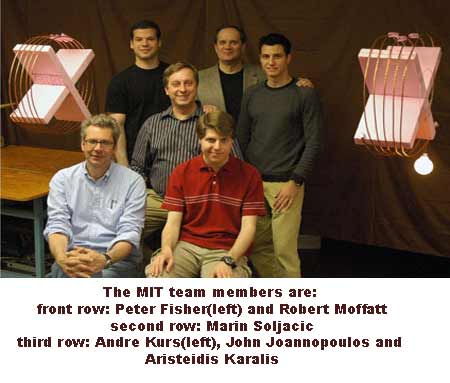Have you thought of reading books on wireless electricity? If you haven’t then start thinking because a research team at the Massachusetts Institute of Technology (MIT) has showcased a new technology, wireless electricity and its named WiTricity.

The MIT team was able to light a 60 Watts light-bulb from a power source seven feet away and most interestingly there was no physical connection between the source and the application.
The MIT team focused on one particular type; magnetically coupled resonators. The team explored a system of two electro-magnetic resonators coupled mostly through their magnetic fields; they were able to identify the strongly coupled regime in this system. The distance between them was several times larger than the size of the resonant objects. This way, efficient power transfer was enabled.
Two 20 inch coils were designed to resonate with one another, with one hooked up to the power supply and the other to a light bulb. As the magnetic fields interact weakly with most other materials, the power can go through walls and more importantly, doesn’t affect the human body.
Prof. John Joannopoulos says, “In the past, there was no great demand for such a system, so people did not have a strong motivation to look into it. Over the past several years, portable electronic devices, such as laptops, cell-phones, iPods, and even household robots have become widespread, all of which require batteries that need to be recharged often.”
Knowing about future, Martin Soljacic, the physics professor who led the team, comments, “Once, when my son was about three years old, we visited his grandparents’ house. They had a 20 year old phone and my son picked up the handset, asking, ‘Dad, why is this phone attached with a cord to the wall?’ That is the mindset of a child growing up in a wireless world. My best response was, ‘It is strange and awkward, isn’t it? Hopefully, we will be getting rid of some more wires, and also batteries, soon.â€
The efficiency is still only around 40%. They are close to getting 100 Watts on the receiving end, which is enough to charge a laptop.
The Army Research Office (Institute for Soldier Nanotechnologies), National Science Foundation, and the Department of Energy has funded this work.





i will be in need of your help to guide the final year proect students as a professor.
waiting for your co-operation
sreekala
Do you have plans on how to do this?
Also, this isn’t anything new, Tesla was doing this in the 1890’s.
Way COOL though!
i want more information about this technology
wat do u think of achieving wireless transmission.and how can 100% efficiency be achieved???
not bad but most of the smaller devices can easily have their own power source like batteries which work for upto 4 hours. which is more than enuf
I charge my cell phone once in 3 weeks.
if the power bill has a difference which is high, it may not be practical, plus high current devices like Fans, ACs, etc still need the wire.
if you can light up one bulb, great , but you still need a wall jack where the wireless power transmitter is located.
its like mobile networks, you need 3 towers in the vicinity of a bigger facility..which ofcourse eliminates the cost of wires but again the power requirements are much lower.